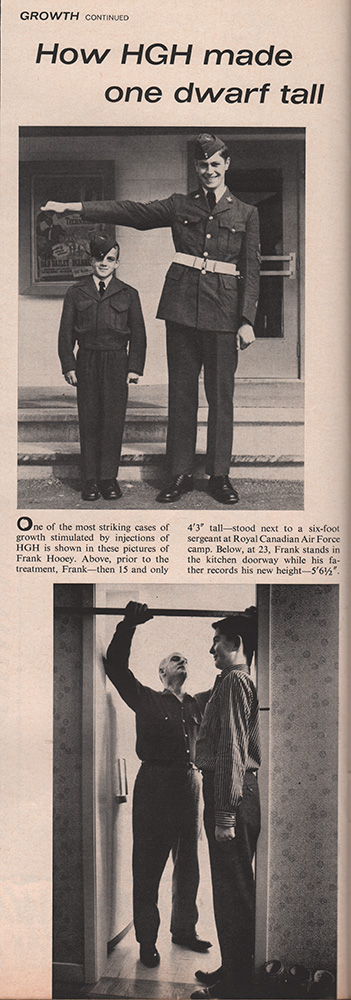-

“The position of the pituitary gland within the skull,” from The Pituitary Gland: Clinical Application of its Hormone Factors, Armour Laboratories, 1940s
Courtesy National Library of Medicine
The pituitary gland, the size of a chick pea, situated in the center of the brain, secretes nine different hormones, one of which regulates human growth.

-

“How HGH Made One Dwarf Tall,” LIFE, October 14, 1966
Courtesy © 1966 Time Inc. Reprinted with permission. All rights reserved. Images courtesy Royal Canadian Air Force.
A young man featured in Life magazine in 1966 gained 15 inches with the help of growth hormone injections. Although the extracted hormone was available for therapeutic use by the late 1950s, its availability was severely restricted by the limited supply of human glands.
How HGH made one dwarf tall
One of the most striking cases of growth stimulated by injections of HGH is shown in these pictures of Frank Hooey. Above, prior to the treatment, Frank—then 15 and only 4’3” tall—stood next to a six-foot sergeant at Royal Canadian Air Force camp. Below, at 23, Franks stands in the kitchen doorway while his father records his new height—5’ 6 ½”.

-

“The Steer” from Armour’s Endocrine and Other Organotherapeutic Preparations, 1940s
Courtesy National Museum of American History
Diagram of glands and organs used for making pharmaceutical preparations.

-

Insulin sales kit, Eli Lilly and Company, 1940s
Courtesy National Museum of American History
In the early 1920s, Canadian researchers isolated insulin from the pancreas glands of animals and successfully treated children with diabetes. They partnered with the American company Eli Lilly to mass produce this life-saving substance. This sales kit illustrates the step-by-step process for manufacturing insulin.

-

Insulin plasmid tubes, 1970s
Courtesy National Museum of American History
These tubes contained samples of bacterial DNA which had been genetically modified to contain the human insulin gene. Researchers used the DNA in the original experiments to produce human insulin from recombinant bacteria.

-

Pituitary gland products, 1910s–1950s
Courtesy National Museum of American History
These bottles contain medicines made from the pituitary glands of cattle. Although these tablets and powders were widely available, they could not have been effective. Any hormones present were destroyed by the human digestive system before they could work. In the 1940s researchers isolated pure growth hormone from cattle glands. This hormone could be injected, but due to differences between species, bovine hormone was not effective for human use.

-

Grow Young with HGH by Dr. Ronald Klatz, 1998
Courtesy Harper Collins and National Museum of American History
Grow Young
With
HGHTHE AMAZING MEDICALLY PROVEN PLAN TO
Lose Fat, Build Muscle
Reverse the Effects of Aging
Strengthen the Immune System
Improve Sexual Performance
Lower Blood Pressure and Cholesterol
BASED ON CUTTING-EDGE SCIENTIFIC RESEARCHDr. Ronald Klatz
President, American Academy of Anti-Aging Medicine
WITH CAROL KAHN
-

“My Little Brother on Drugs” by Jenny Everett, Popular Science, April 2004
Used with permission of Popular Science Copyright ©2013. All rights reserved.
The experience of a young boy on hGH therapy prompted his sister to ask, “Should we treat stature as a medical condition?”
MY LITTLE BROTHER ON DRUGS
Last July, 9-year-old Alex Everett received his first shot of synthetic human growth hormone—an injection he’ll get every night for eight years. Alex isn’t sick—he’s short. Should we be treating stature as a medical condition? By Jenny Everett
PHOTOGRAPHS BY JOHN B. CARNETT

-

Posilac, recombinant bovine growth hormone, Monsanto Company, 1994
Courtesy National Museum of American History
Following the success of human growth hormone (hGH), researchers developed a recombinant bovine (cow) growth hormone, which became available in 1994. The drug did not treat a disorder in cattle, but instead drug companies marketed the substance to dairy farmers to increase milk production.

![]() Hormones are complex molecules that regulate vital functions, including growth and development. In humans and animals, hormones are produced in glands and organs such as the pituitary, thyroid, and pancreas.
Hormones are complex molecules that regulate vital functions, including growth and development. In humans and animals, hormones are produced in glands and organs such as the pituitary, thyroid, and pancreas.
Before recombinant DNA technology, drug manufacturers extracted hormones, including insulin and growth hormone, directly from animal or human glands. Human growth hormone (hGH) required a supply of pituitary glands from human cadavers that was difficult to obtain.
The new technology ensured an abundant supply of these drugs. In the case of hGH, the number of children requiring it to treat pituitary gland disorders is quite small. However, with the supply secure new markets and applications emerged. The drug is used to increase height in otherwise healthy children, to enhance athletic performance, and to rejuvenate aging bodies.











